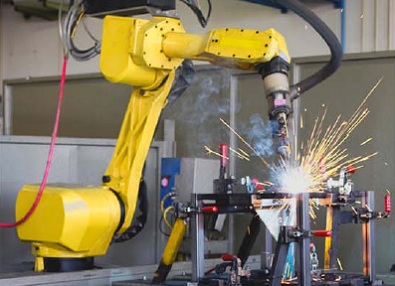Over the past several years we have seen a tremendous increase in the amount of automation in our everyday lives. This is no different in the welding industry. Gone are the days when you needed to make 50,000 identical parts to justify a robot. With prices going down and quality, reliability and flexibility going up, arc welding robotic systems are much easier to justify these days. Ten to fifteen years ago you had to spend roughly $150,000 to $200,000 to get a basic robotic cell. Today $65,000 – $80,000 can get you a basic turnkey system.

The big question is: CAN you justify the purchase of a robot?
Take a look at the questions below. If you answer “YES” to three or more then you probably need to consider welding automation in your facility.
1. Is arc welding an important part of your manufacturing process?
2. Do you have quality problems?
3. Are you struggling to find and hire qualified welders?
4. Do you find that your trained welders are leaving for better paying jobs, thus increasing your training expense?
5. Do you have commonality between parts?
6. Are the dimensions repeatable?
7. Can your welding fixtures do a good job of holding parts in the same place for welding each time?
8. Are your competitors installing or already using robotic arc welding systems?
9. Are your labor costs increasing?
If you answered “YES” to three or more of these questions then you probably are a good candidate for a robotic welding system. Automation of welding operations takes a lot of work. It is not as simple as buying the system and putting it in place. There is a learning curve. Don’t get to ambitious with your first cell. Start small. Crawl before you walk. Make sure you have plenty of support from your vendor and the manufacturer of the equipment, you’re going to need it.
Once you have your system installed and all the bugs have been worked out you can expect the following:
– Increase productivity by a minimum of 100% on the parts being robotically welded
– Increase quality and consistency
– Reduce operator cost (lower cost to employ an operator than a welder and higher productivity)
– Reduce training costs
– Reduce material costs (weld are properly sized so no wasted wire)
– Reduce work-in process inventory
– Reduce consumption of shielding gas due to faster travel speeds
– Reduce problems associated with heat input
– Reduce weld inspection costs
– Provide ability to track production data (this is also available no for manual operations)
– Provide higher productivity by square foot of floor space
Many times the big issue is not whether or not automation can be justified, or whether or not it is necessary. The biggest hurdle, especially for small companies is the initial investment. Despite lower costs today, a robot purchase is still as significant capital expenditure. If you are unable to make this investment keep this in mind: Most fabricating companies can reduce costs in their welding operations by at least 25% by taking care of simple things. If you need some ideas on how to reduce costs for manual and semi-automatic operations read 12 Ideas to Reduce Welding Costs.
One concern with going into automation is the loss of jobs. This is a misconception. Although automation can certainly replace welders, it typically creates more jobs. It allows companies to redistribute their workforce and become more profitable. Robots still need to be operated and programmed. If you are a welder and are concerned about automation replacing your job then be the one that takes an interest in it. Learning to program a robot is so much easier than learning how to weld.
Automation is growing in our industry, but it will not replace every welding job. And guess what, at least in the U.S., there there are approximately 350,000 to 400,000 available jobs for welders today! The shortage of skilled welders is huge. Automation is being used to bridge the gap, not to replace welders.

I like the fact that robotic arc welding can reduce the company’s operational costs while increasing the efficiency and quality of the products being manufactured using this process. I’ve watched robots doing some industrial work for the manufacturers on TV and imagined the precision of work and unlimited hours it can operate while maintaining the consistency of quality across all commodities. If I were to own a car manufacturing company, investing on robotic welding will be my utmost priority to make good money and keep loyal clients with the quality I can provide.
Great article. I really appreciate the insight here in this post. Thanks for sharing it.
We’re glad you found it useful Sharon!